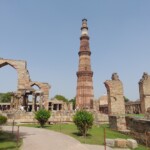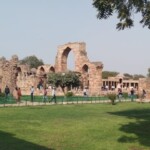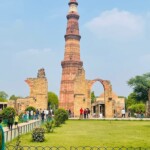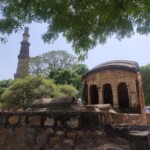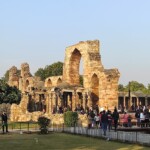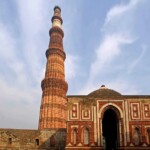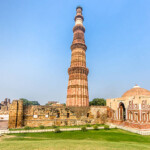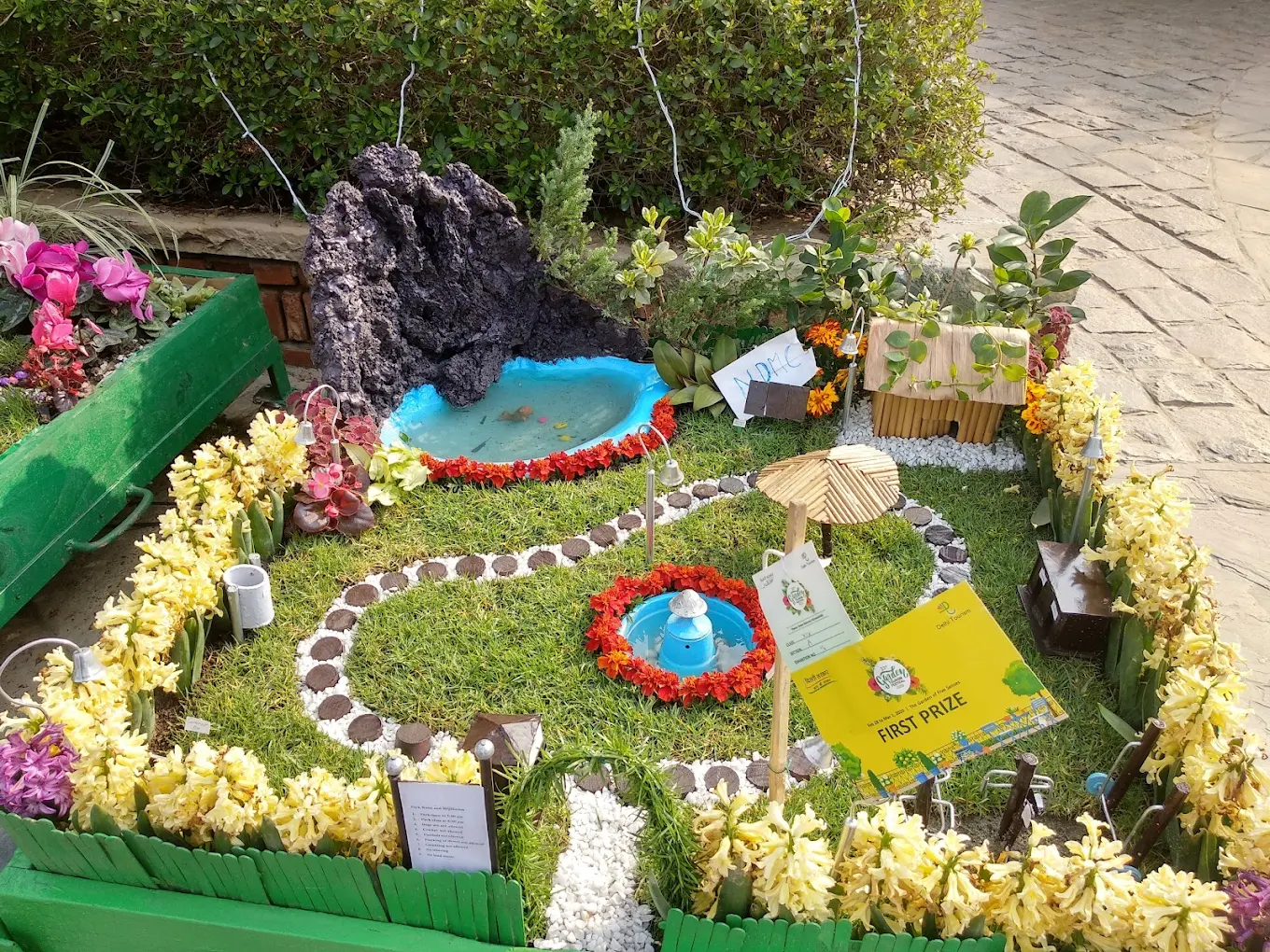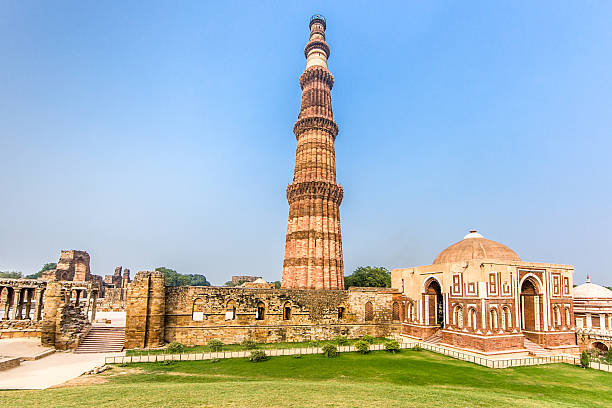
Qutub Minar: Unveiling the Majestic Icon of Delhi
Delhi, the bustling capital of India, is home to numerous historical treasures, but one structure that stands tall, captivating visitors from around the world, is the magnificent Qutub Minar. With its impressive height and intricate architecture, this UNESCO World Heritage Site is a testament to India’s rich heritage. In this article, we delve into the captivating history, architectural marvel, and experiences offered by Qutub Minar.
Qutub Minar Entry Fee
₹35 per person for Indians in Debit & Credit Card
₹40 per person for Indians in Cash
₹0 per child (below 13 Years)
₹500 per person for Foreign Tourists
Qutub Minar Delhi Timings
| Day | Timing |
| Monday | 7:00 am – 5:00 pm |
| Tuesday | 7:00 am – 5:00 pm |
| Wednesday | 7:00 am – 5:00 pm |
| Thursday | 7:00 am – 5:00 pm |
| Friday | 7:00 am – 5:00 pm |
| Saturday | 7:00 am – 5:00 pm |
| Sunday | 7:00 am – 5:00 pm |
Historical Significance of Qutub Minar
Qutub Minar holds great historical importance, reflecting the shifting dynasties and cultural influences that shaped Delhi’s past. The construction of Qutub Minar was initiated by Qutb-ud-din Aibak, the first Muslim ruler of Delhi, in 1192. It was later expanded by his successor, Iltutmish. The minar stands as a symbol of victory and marks the onset of the Delhi Sultanate.
Architectural Marvel of Qutub Minar
Design and Construction
Qutub Minar showcases a remarkable blend of Indo-Islamic architecture. The tower is predominantly constructed using red sandstone, adorned with intricate carvings and verses from the Quran. The architectural style incorporates influences from both Hindu and Persian craftsmanship, resulting in a unique and visually stunning structure.
Height and Structure
Soaring to a height of approximately 73 meters, Qutub Minar is the tallest brick minaret in the world. The minar is divided into five distinct stories, each marked by intricately carved balconies. The tapering structure features intricate geometric patterns, calligraphy, and motifs, making it a marvel of medieval Indian architecture.
Exploring Qutub Minar Complex
Qutub Minar is not just a solitary tower but a complex housing several other remarkable structures. Let’s explore some of the notable attractions within the complex:
Quwwat-ul-Islam Mosque
Adjacent to the minar, the Quwwat-ul-Islam Mosque is one of the oldest mosques in India. Its construction was initiated by Qutb-ud-din Aibak and completed by subsequent rulers. The mosque showcases a fusion of Hindu and Islamic architectural elements, with intricately carved pillars and arched gateways.
Alai Darwaza
As you wander through the complex, you’ll come across the imposing Alai Darwaza. This grand gateway was built by Ala-ud-din Khilji, known for his military conquests. The Alai Darwaza showcases intricate Islamic calligraphy, stunning arches, and decorative embellishments, providing a glimpse into the architectural brilliance of the time.
Iron Pillar
Near the entrance of the complex, you’ll find the famous Iron Pillar. This ancient iron pillar dates back to the 4th century and has intrigued scientists for centuries due to its rust-resistant composition. The pillar stands as a testament to the advanced metallurgical skills of ancient India.
Timings and Entry Fee
Qutub Minar is open for visitors from sunrise to sunset. The entry fee for Indian nationals is INR 35, while for foreign tourists, it is INR 500. It is advisable to check the official website or local sources for any updates on timings or entry fees before your visit.
Location and How to Get There
Qutub Minar is located in Mehrauli, a historic neighborhood in South Delhi. The nearest metro station is Qutub Minar, which is part of the Yellow Line. From there, you can take a short auto-rickshaw ride or walk to reach the monument. It is recommended to use public transportation or hire a local cab to navigate through Delhi’s bustling streets.
Unveiling the History of Qutub Minar
Qutb-ud-din Aibak and the Early Period
Qutub Minar owes its inception to Qutb-ud-din Aibak, who began its construction after the defeat of Delhi’s last Hindu ruler. Aibak, a skilled military general, established the Delhi Sultanate and laid the foundation of the Qutub Minar complex as a symbol of his triumph.
Iltutmish and the Expansion
Following the demise of Aibak, his successor, Iltutmish, took charge and expanded Qutub Minar by adding three more stories. Iltutmish’s reign witnessed further architectural enhancements, including the construction of the Quwwat-ul-Islam Mosque.
Alai Minar: Unfinished Dream
Ala-ud-din Khilji, another prominent ruler of the Delhi Sultanate, had ambitious plans to surpass the height of Qutub Minar by building an even taller minar called the Alai Minar. However, this dream remained unfulfilled as only the foundation was laid, and the minar was never completed.
Capturing the Beauty: Qutub Minar in Images
Experiencing the Charm of Qutub Minar
Visiting Qutub Minar is a sensory delight. Here are some experiences you shouldn’t miss during your visit:
Best foods to eat while visiting Qutub Minar in Delhi:
- Paranthas at Paranthe Wali Gali: Indulge in the delectable variety of stuffed paranthas, a popular North Indian dish, at Paranthe Wali Gali in Old Delhi. From potato and paneer to sweet fillings like rabri, these piping hot paranthas are a must-try culinary delight.
- Butter Chicken at Moti Mahal: Treat your taste buds to the iconic Butter Chicken at Moti Mahal, a legendary restaurant known for its rich and flavorful North Indian cuisine. The succulent pieces of tandoori chicken cooked in a creamy tomato-based gravy are sure to leave you craving for more.
- Kebabs at Karim’s: Head to Karim’s, located near Jama Masjid, to savor the mouthwatering kebabs they are famous for. From juicy seekh kebabs to melt-in-your-mouth boti kebabs, the flavors and aromas will transport you to culinary heaven.
- Chole Bhature at Sita Ram Diwan Chand: Dive into the delicious world of Chole Bhature at Sita Ram Diwan Chand, a renowned eatery specializing in this popular Punjabi dish. The fluffy bhature (deep-fried bread) paired with spicy and tangy chole (chickpea curry) will leave you completely satisfied.
- Street Food Delights at Chandni Chowk: Explore the bustling lanes of Chandni Chowk, where you’ll find a plethora of street food options. From crispy samosas and spicy golgappas (pani puri) to refreshing falooda and creamy rabri, the vibrant street food scene offers an array of flavors to tantalize your taste buds.
Remember to sample these delicacies at reputable and hygienic establishments to ensure a safe and enjoyable culinary experience. Enjoy the diverse flavors of Delhi’s street food and immerse yourself in the gastronomic delights while exploring the historic Qutub Minar
Marveling at the Architecture
As you stand before the towering minar, take a moment to appreciate the intricate carvings, geometric patterns, and calligraphy adorning the structure. Each balcony unveils a new level of craftsmanship, leaving you in awe of the architectural genius of the past.
Climbing to the Top
If you’re up for an adventurous ascent, climb the spiral staircase inside the minar. As you ascend, you’ll witness breathtaking panoramic views of Delhi’s skyline. Be prepared for the narrow staircase and limited space inside, as it can be challenging for those with mobility issues.
Soaking in the Serenity
Qutub Minar’s complex offers tranquil spaces where you can relax and soak in the historical ambiance. Find a quiet corner amidst the ancient ruins, sit back, and let the serenity wash over you. It’s a perfect spot to reflect on the rich history and cultural heritage that surrounds you.
Conclusion
Qutub Minar in Delhi stands tall, narrating tales of bygone eras and showcasing the architectural brilliance of the past. From its historical significance to its captivating design, the minar offers a glimpse into the cultural mosaic of India. Visit this iconic landmark, immerse yourself in its rich history, and create memories that will last a lifetime.
For what is Qutub Minar famous for?
Qutub Minar is famous for its historical significance, architectural beauty, and being the tallest brick minaret in the world.
What is Qutub Minar in 3 points?
Qutub Minar is a historical monument in Delhi, India. It is a UNESCO World Heritage Site and dates back to the 12th century. The minaret is known for its intricate architecture and stands as a symbol of the Delhi Sultanate.
Which day is Qutub Minar closed?
Qutub Minar is closed on Mondays.
Who built Qutub Minar first?
The construction of Qutub Minar was started by Qutb-ud-din Aibak, the founder of the Delhi Sultanate, in the early 13th century. It was later completed by his successor, Iltutmish.
Why is Qutub Minar blue?
Qutub Minar is not blue in color. It is made of red sandstone, which gives it a reddish-brown hue. The perception of the minaret appearing blue may be due to various factors such as lighting conditions, weather, or photography techniques.
Did Qutub Minar have 7 floors?
Yes, Qutub Minar originally had seven floors. However, the topmost two floors were damaged and reconstructed, reducing the current number of floors to five. The lower three floors are made of red sandstone, while the upper two floors are made of marble and sandstone.
What is the Hindu name for Qutub Minar?
The Hindu name for Qutub Minar is “Dhruvasthan.” It is believed that the minaret was built on the site where a mythical pillar, said to be the axis of the world, existed in ancient Hindu cosmology.
What is inside the Qutub Minar?
Inside Qutub Minar, there is a spiral staircase consisting of 379 steps that lead to the top. However, public access to the interior of the minaret is not allowed for safety reasons.
What is the nickname of Qutub Minar?
Qutub Minar is often referred to as “Tower of Victory.” This nickname highlights its historical significance and grandeur as a symbol of triumph.
What is unique about Qutub Minar?
One of the unique aspects of Qutub Minar is its architectural style, which combines elements of Persian, Indian, and Islamic design. It also showcases intricate carvings, calligraphy, and ornamental features that make it a remarkable historical structure.
What is the height of Qutub Minar?
The height of Qutub Minar is approximately 72.5 meters (238 feet). It is the tallest brick minaret in the world and has five distinct storeys, each marked by a projecting balcony.
Can visitors climb Qutub Minar?
No, visitors are not allowed to climb Qutub Minar for safety reasons. However, you can admire the minaret’s beauty and explore the surrounding complex that houses other historical structures and ruins.
Are there any nearby attractions to visit?
Yes, there are several attractions near Qutub Minar that you can visit. Some popular nearby sites include the Iron Pillar, Alai Darwaza, Quwwat-ul-Islam Mosque, and the Mehrauli Archaeological Park.
What is the significance of the Iron Pillar?
The Iron Pillar is a prominent attraction near Qutub Minar. It is a remarkable metallurgical marvel dating back to the 4th century. The pillar stands as a testament to the advanced ironworking techniques of ancient India and bears inscriptions in Sanskrit.
Can I take photographs inside the complex?
Yes, you are allowed to take photographs inside the Qutub Minar complex. However, there may be specific areas or restrictions where photography is prohibited for the preservation of the historical structures and artefacts.
Further Reading:
India Gate Delhi Entry Fee, Timings, History, Images & Location
Kalka Ji Mandir Delhi कालकाजी मंदिर,दिल्ली Timings, History, Entry Fee, Images, Aarti, Location
Akshardham Temple Delhi, History, Timings, Entry Fee, Architecture, Images & Location
Chhatarpur Temple Delhi, Pooja, Entry Fee, Aarti Timings
Best Places to Visit in New Delhi 2023
Top 13 Places worth visiting in Delhi!!
Delhi – The National Capital City with Historical Importance

